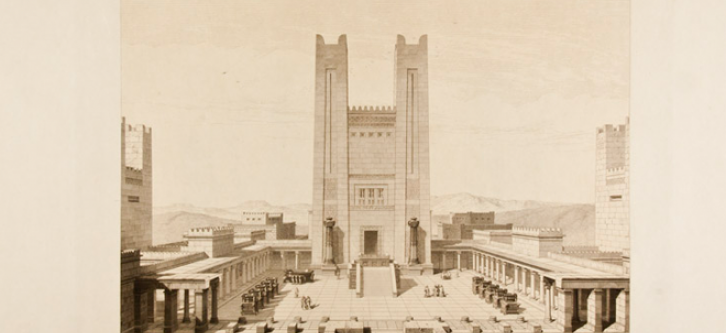Over the course of my week, I read through most of the new catalogs published by ABAA member and survey items newly listed on abaa.org. The books detailed below are the ones that caught my eye this week for various reasons.
Chipiez, Charles; Georges Perrot
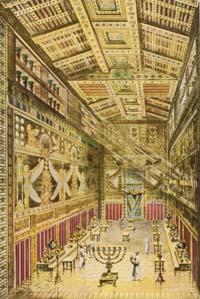 Paris: Librairie Hachette, 1889. First edition. Hardcover. Elephant folio (28 1/4" x 23"). [2], 86, [2] p., [10] leaves of plates. Contemporary 3/4 calf over marbled paper covered boards, with gold lettering on spine. Top edge gilt. Marbled endpapers. Ribbon marker. Original wrappers bound in. Decorative head- and tailpiece. Remarkable work by architect and architectural historian Charles Chipiez and archaeologist georges Perrot which shows a theoretical reconstruction of the Temple of Jerusalem. The authors present their imagery as a restitution of Ezechiel's vision. This book contains 38 b/w in-text illustrations and 10 leaves of plates (plates measuring 28" x 22 1/2", with illustrations in various sizes.) The plates are engraved after Charles Chipiez's designs by Guillaumot père (i.e. Auguste Alexandre Guillaumot) and Auguste Hibon. Plate X is a line photogravure, signed "Heliog. Dujardin" (Louis Dujardin). Plate no. XI is a hand-colored lithograph by Joseph Isnard Louis Desjardins and was displayed as the final work of the 2008/2009 "Reflections of the Temple" exhibit (Israel Museum, Jerusalem). This exceptional work is a Deluxe copy with text and plates on Japon vellum. Moderate rubbing along edges of binding. Head and tail of spine rubbed with slight abrasion. 1" closed tear on upper front joint. Upper front cover slightly discolored. Text in French. Binding in overall good+, interior in near fine to fine condition. vg.
Paris: Librairie Hachette, 1889. First edition. Hardcover. Elephant folio (28 1/4" x 23"). [2], 86, [2] p., [10] leaves of plates. Contemporary 3/4 calf over marbled paper covered boards, with gold lettering on spine. Top edge gilt. Marbled endpapers. Ribbon marker. Original wrappers bound in. Decorative head- and tailpiece. Remarkable work by architect and architectural historian Charles Chipiez and archaeologist georges Perrot which shows a theoretical reconstruction of the Temple of Jerusalem. The authors present their imagery as a restitution of Ezechiel's vision. This book contains 38 b/w in-text illustrations and 10 leaves of plates (plates measuring 28" x 22 1/2", with illustrations in various sizes.) The plates are engraved after Charles Chipiez's designs by Guillaumot père (i.e. Auguste Alexandre Guillaumot) and Auguste Hibon. Plate X is a line photogravure, signed "Heliog. Dujardin" (Louis Dujardin). Plate no. XI is a hand-colored lithograph by Joseph Isnard Louis Desjardins and was displayed as the final work of the 2008/2009 "Reflections of the Temple" exhibit (Israel Museum, Jerusalem). This exceptional work is a Deluxe copy with text and plates on Japon vellum. Moderate rubbing along edges of binding. Head and tail of spine rubbed with slight abrasion. 1" closed tear on upper front joint. Upper front cover slightly discolored. Text in French. Binding in overall good+, interior in near fine to fine condition. vg.
Spotted in the recent Judaica catalog from Eric Chaim Kline Bookseller...
If you'd spent as many years in religious school as I have, you couldn't scroll past a theoretical reconstruction of the Second Temple either.
This item description by Garrett Scott is a wonderful example of the delightfully odd things you can learn from reading through a bookseller's catalog. Not only do we discover a little-known episode from the story of Dr. Peter Mark Roget -- who invented the famous (at least to those of us educated in the pre-digital age) Roget's Thesaurus as a coping mechanism for his depression (he was an obsessive maker of lists) -- but we also learn about an archaic use of the word economic.
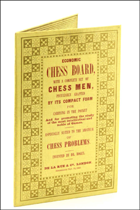 Economic Chess Board, With a Complete Set of Chess Men, Peculiarly Adapted by its Compact Form for Carrying in the Pocket and for Promoting the Study of the Most Intellectual and Noble of Games. Especially Suited to the Amateur of Chess Problems. Invented by Dr. Roget.
Economic Chess Board, With a Complete Set of Chess Men, Peculiarly Adapted by its Compact Form for Carrying in the Pocket and for Promoting the Study of the Most Intellectual and Noble of Games. Especially Suited to the Amateur of Chess Problems. Invented by Dr. Roget.
London De La Rue & Co., Registered Nov. 10 1845 [but ca. 1850s-1860s?]. Folding chessboard of gilt-patterned glazed yellow paper over card stock, printed in red, approx. 5.75 x 3.75 inches folded (5.75 x 7.25 open), chess board interior of heavy paper strips printed in black and red. Paper chess pieces printed in black and red. Original slipcase with gilt-patterned glazed paper over card stock. Evidently an early (but not first) edition.
The industrious Peter Mark Roget (1779-1869) is best remembered for his Thesaurus, but was also known both for his restless inventiveness and his skill with chess puzzles. This attractive early example of the Roget Economic Chess Board—dating from when “economic” was a term to conjure by, suggesting all that was modern and up-to-date—is fine example both of mid-Victorian design (with its gilt-printed glazed paper) and of the Whiggish insistence on self-improvement and economic utility; with this model, the chess pieces are slips rather than the button-style pieces as is sometimes seen with De La Rue traveling models.
The bibliography of the Roget Economic Chess Board remains a trifle obscure, to this cataloguer at least, as Longmans appears to have published it (and advertised it heavily in its publications) ca. 1846-1847, though at least one reference in a Staunton column from mid-1846 notes De La Rue as the maker of the board. De La Rue also later published “improved” travel chess sets without the Roget “Economic” brand. A few slight small stains to the board and to the slipcase; some minor wear; in fine condition.
This item is not listed on abaa.org, but you'll find it in Garrett Scott's new catalog "Occasional List #42" (item #6)...
Gascoigne's Princely Pleasures, with the Masque, Intended to Have Been Presented before Queen Elizabeth, at Kenilworth Castle in 1575; with an Introductory Memoir and Notes.
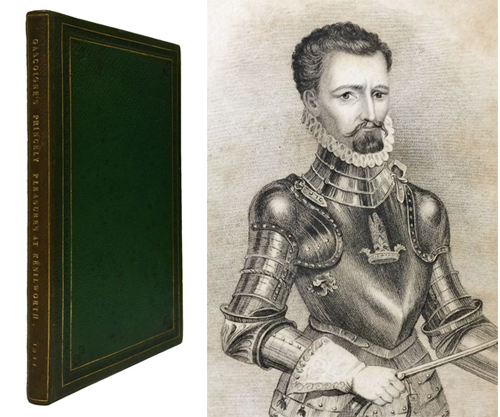
Elizabeth I's reign has been picked over relentlessly by artists and writers in a never-ending series of romance novels, scholarly studies, and cinematic melodramas, all contributing to the considerable body of myth that surrounds the "Virgin Queen." However, Honey & Wax Booksellers remind us that myth-making and propaganda are not an invention of the modern world, by sharing the story of Lord Robert Dudley's elaborate attempts to impress Elizabeth I and forward his case to be her husband through the dramatic arts.
From the description:
"London: Printed for J.H. Burn... 1821. Twelvemo, contemporary full green pebbled morocco, frontispiece portrait of Gascoigne. Near fine.
In an extravagant effort to impress the queen, and likely in an attempt to win her hand in marriage, Dudley planned a elaborate entertainments, including hunts, fireworks, and plays. Elizabethan poet and actor George Gascoigne was placed in charge of the performances, which began with a welcome from legendary figures such as the Lady of the Lake and Hercules. Gascoigne’s own lyrical contributions emphasized Dudley’s ancient lineage, connected even to King Arthur, subtly suggesting that Dudley was a worthy match for the queen.
Gascoigne’s verses, originally printed one year after the revels, would themselves influence the likes of Philip Sidney and Ben Jonson. Early nineteenth-century edition of the revels at Kenilworth staged for Elizabeth I, the first separate edition since the 1576 first printing, which is no longer extant. Elizabeth I stayed at Kenilworth, the seat of her childhood friend Lord Dudley, Earl of Leicester, for nineteen days."
Not listed on abaa.org, but you'll find this beautiful copy of Gascoigne's Princely Pleasures in the new catalog from Honey & Wax Booksellers, Myth/Fable/Fairy Tale (item #3)...
Socializing Children - A Collection of over 420 Vintage Advertising Paper Dolls, from the Victorian era to the mid-1900s
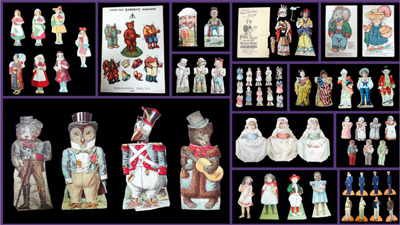
From the description:
"Give-aways and premiums were introduced in as a marketing tool by the Grand Union Tea Company in 1873. They quickly caught on as a means of promoting products to establish customer relationships and encourage repeat business by creating an emotional bond to premium perhaps more than the product. Toys and in this instance paper dolls were often linked to the product and available free with the product or available for the price of postage. Persuasive children desiring the paper toys becoming a pawn of the advertiser. Most of the materials in this collection are from the Victorian era. The invention of color lithography allowed printers to produce large quantities of relatively inexpensive colorful, attractive prints. As noted above, companies attempting to promote their various goods soon began to utilize this process to print series of paper dolls aimed to entice children in order to use them to against their parents in hopes that they would buy their product. Since the dolls normally ran in series, multiple purchases were nearly a given to complete a set. This was a fairly successive marketing strategy used by lots of companies supplying a variety of products, from baking items and tobacco, to coffee or shoe polish. Although intended as a mechanism to sell product these premiums knowing or unknowingly helped to socialize children by demonstrating role models, gender roles, acceptable social performance and more. Additionally, they presented a window into society, as the subjects of the paper dolls often reflected “the finer things in life” that many children weren’t easily afforded. McLaughlin Coffee in particular presented imagery of upper class and privileged individuals and their environs..."
The full description (and that of similar items) is well worth reading in Eclectibles' latest ephemera catalog... (item #25)
As one of the millions seduced by Star Wars cards packaged with rather tasteless bubblegum in the 1970s, I've always been interested in the premiums and tchotchkes used to entice us to want things. When my own children hit that impressionable age it was Doctor Who cards that caught their fancy; I was relieved to find that the cheap bubble gum had been removed and the production value of the cards had improved a great deal. However, I'm sure they would have loved to collect paper dolls like this wonderful collection had the use of such inducements still been in fashion. Eclectible's description is like a mini-history lesson, and certainly interests me in learning more about this kind of ephemera, and perhaps collecting it!
And speaking of Star Wars cards, did you know Topps released an app in which you can collect (and I use the term loosely) every series of cards they ever released? Somehow I'm not sure an app could have quite the same allure that bundles of cards rubber-banded together in an old showbox had in the late 1970s (and judging by the scathing, one-star reviews for the app in the App Store, today's teens are not impressed either). Just another way technology can imitate but not replace the past.
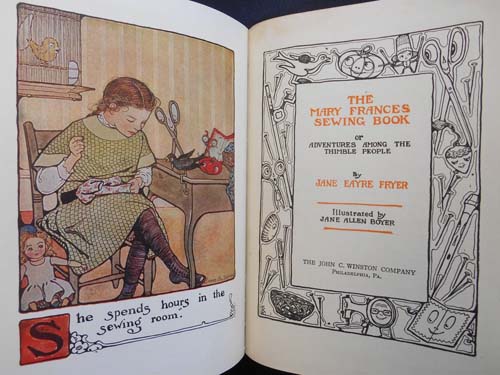
From the description:
"Philadelphia: The John C. Winston Company (1913), 1913. 1st Edition. Hardcover. Very Good. Boyer, Jane Allen. 8vo - over 7" - 9" tall. 280 p. All 10 fold-out patterns present, complete and all but one being uncut (both the tissue patterns and the underlying paper patterns). The "Mary Frances" series was designed to teach young girls domestic skills, such as knitting, cooking, gardening, and housekeeping. Made fun through the use of colourful illustrations and, at least in this book, interaction with talking animals and Fairies, the books were meant to be used - hence, relatively few survive with all patterns intact."
I love the art and can appreciate just how much of a miracle it is that this copy survives with "all patterns intact." Offered by Swan's Fine Books. (Full description available on abaa.org...)
The Transatlantic Reviw (1924) Featuring new work from James Joyce, Gertrude Stein, & Ernest Hemingway, among others!
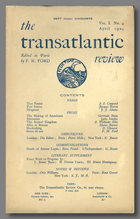
From the description:
"Paris, London & New York: Transatlantic Review Co., 1924. I:4. Large octavo. Printed wrappers. Usual tanning to text stock, some light smudges to upper wrapper and spine, a few tiny nicks and closed tears at the extremities of the extended overlap wrapper edges, but a quite nice copy, unopened, very good or better, and substantially above the norm. A watershed number of Ford's distinguished expatriate journal, edited and printed in Paris, and distributed in France, London (by Duckworth) and New York (by Seltzer). This copy is in the less common wrapper for French distribution. Contributors to this issue include Joyce (the first publication of a fragment from, and the source for the operative designation as, "Work in Progress"), Hemingway (untitled, but "Indian Camp"), Coppard, Stein (installment I of "The Making of Americans"), Barnes, Ford, Tzara, Crevel, et al."
Offered by William Reese Company.
An authentic piece of literary history from the "lost generation" expats; what's not to love?
There are two places collectors need to keep an eye on to review the latest offerings from ABAA members as they happen.
New Arrivals -- Where the most-recent books listed on abaa.org appear.
New Catalogs -- The latest books cataloged by members (these items are not usually listed on abaa.org).
Bookmark those links and check them out regularly to see the latest items offered by our members. Good luck!
More highlights next week...


